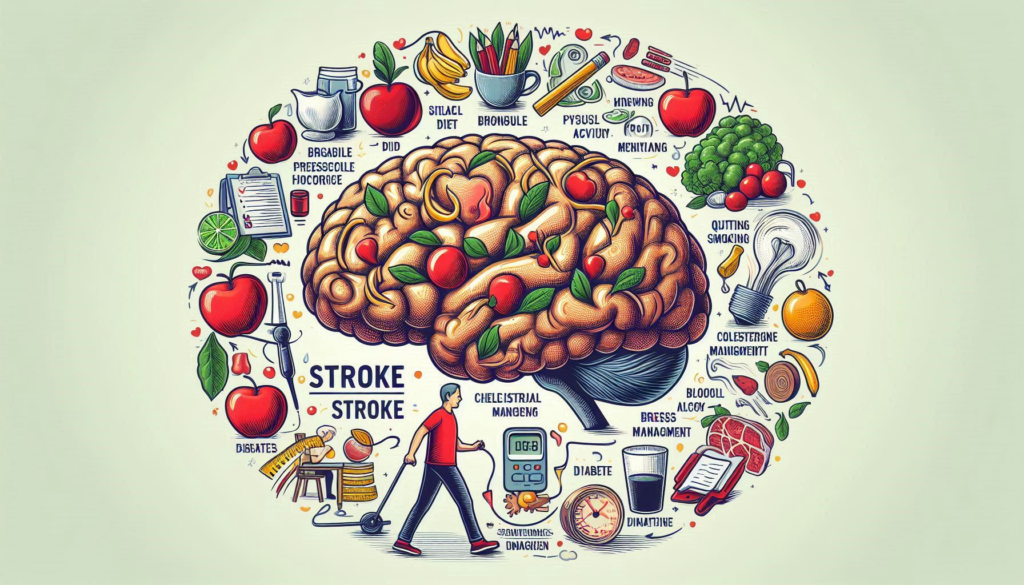
Brain Stroke: 10 Effective Prevention Tips
Brain Stroke: 10 Effective Prevention Tips
Learn 10 effective tips to prevent brain stroke and protect your health. Discover practical strategies to reduce risk factors and maintain a healthy lifestyle.


Introduction
Brief Overview of Brain Stroke and Its Impact on Health
A brain stroke, also known as a cerebrovascular accident (CVA), occurs when the blood supply to a part of the brain is interrupted or reduced, preventing brain tissue from getting the oxygen and nutrients it needs. This can lead to brain damage, disability, or even death. Strokes are a leading cause of serious long-term disability and can have a profound impact on an individual’s quality of life.
Importance of Stroke Prevention and Maintaining Brain Health
Preventing strokes is crucial for maintaining overall brain health and reducing the risk of long-term complications. By adopting healthy lifestyle habits and managing risk factors, individuals can significantly lower their chances of experiencing a stroke. Maintaining brain health through proper diet, exercise, and stress management is essential for overall well-being.
Overview of the 10 Effective Prevention Tips
This article outlines 10 effective tips for preventing brain strokes, including maintaining a healthy diet, regular physical activity, managing blood pressure, controlling cholesterol levels, quitting smoking, limiting alcohol consumption, managing diabetes, maintaining a healthy weight, and stress management.
Section 1: Understanding Brain Stroke
Definition and Types of Brain Stroke
A brain stroke occurs when the blood supply to a part of the brain is interrupted or reduced. There are two main types of strokes:
- Ischemic Stroke: Caused by a blockage in an artery that supplies blood to the brain. This is the most common type of stroke.
- Hemorrhagic Stroke: Caused by a ruptured blood vessel in the brain, leading to bleeding in or around the brain.
Common Symptoms and Warning Signs of a Stroke
- Sudden numbness or weakness in the face, arm, or leg, especially on one side of the body.
- Sudden confusion, trouble speaking, or understanding speech.
- Sudden trouble seeing in one or both eyes.
- Sudden trouble walking, dizziness, loss of balance, or coordination.
- Sudden severe headache with no known cause.
Risk Factors Associated with Brain Stroke
- Age: The risk of stroke increases with age.
- Genetics: A family history of stroke can increase the risk.
- Lifestyle: Factors such as smoking, poor diet, lack of physical activity, and excessive alcohol consumption can increase the risk of stroke.
Section 2: Maintain a Healthy Diet
Importance of a Balanced Diet in Stroke Prevention
A balanced diet is essential for maintaining overall health and reducing the risk of stroke. A diet rich in fruits, vegetables, whole grains, and lean proteins can help lower blood pressure, reduce cholesterol levels, and maintain a healthy weight.
Foods That Promote Brain Health
- Fruits and Vegetables: Rich in vitamins, minerals, and antioxidants that support brain health.
- Whole Grains: Provide essential nutrients and fiber that help maintain healthy blood vessels.
- Lean Proteins: Such as fish, poultry, and legumes, which support overall health and reduce stroke risk.
Foods to Avoid to Reduce Stroke Risk
- High-Sodium Foods: Can increase blood pressure and stroke risk.
- High-Fat Foods: Particularly those high in saturated and trans fats, which can raise cholesterol levels.
- Sugary Foods and Beverages: Can contribute to obesity and diabetes, increasing stroke risk.
Tips for Creating a Heart-Healthy Meal Plan
- Plan Balanced Meals: Include a variety of fruits, vegetables, whole grains, and lean proteins in your diet.
- Limit Processed Foods: Reduce intake of processed and packaged foods that are high in sodium, sugar, and unhealthy fats.
- Stay Hydrated: Drink plenty of water and limit sugary drinks and alcohol.
Section 3: Regular Physical Activity
The Role of Exercise in Reducing Stroke Risk
Regular physical activity helps maintain a healthy weight, lower blood pressure, and improve cholesterol levels, all of which reduce the risk of stroke. Exercise also promotes overall cardiovascular health and enhances brain function.
Types of Physical Activities Beneficial for Stroke Prevention
- Aerobic Exercises: Such as walking, running, swimming, and cycling, which improve cardiovascular health.
- Strength Training: Helps build muscle and maintain a healthy weight.
- Flexibility and Balance Exercises: Such as yoga and tai chi, which improve overall fitness and reduce the risk of falls.
Tips for Incorporating Regular Exercise into Your Daily Routine
- Set Realistic Goals: Start with achievable fitness goals and gradually increase intensity.
- Find Activities You Enjoy: Choose exercises that you find enjoyable to stay motivated.
- Make Exercise a Habit: Incorporate physical activity into your daily routine, such as taking the stairs instead of the elevator or going for a walk during lunch breaks.

Section 4: Manage Blood Pressure
The Link Between High Blood Pressure and Stroke Risk
High blood pressure is a major risk factor for stroke. It can damage blood vessels, making them more susceptible to blockages and ruptures. Managing blood pressure is crucial for reducing stroke risk.
Strategies for Monitoring and Managing Blood Pressure
- Regular Monitoring: Check your blood pressure regularly to keep track of your levels.
- Healthy Diet: Follow a diet low in sodium and rich in fruits, vegetables, and whole grains.
- Regular Exercise: Engage in physical activity to help lower blood pressure.
- Medications: Take prescribed medications as directed by your healthcare provider.
Lifestyle Changes and Medications That Can Help Control Blood Pressure
- Reduce Sodium Intake: Limit consumption of salty foods and use herbs and spices for flavor.
- Maintain a Healthy Weight: Achieve and maintain a healthy weight through diet and exercise.
- Limit Alcohol Consumption: Drink alcohol in moderation or avoid it altogether.
- Take Medications as Prescribed: Follow your healthcare provider’s instructions for blood pressure medications.
Section 5: Control Cholesterol Levels
The Impact of High Cholesterol on Stroke Risk
High cholesterol levels can lead to the buildup of plaque in the arteries, increasing the risk of blockages and stroke. Managing cholesterol levels is essential for stroke prevention.
Dietary and Lifestyle Changes to Lower Cholesterol Levels
- Healthy Diet: Eat foods low in saturated and trans fats, and high in fiber.
- Regular Exercise: Engage in physical activity to help lower cholesterol levels.
- Quit Smoking: Smoking can raise cholesterol levels and damage blood vessels.
Medications and Treatments for Managing Cholesterol
- Statins: Medications that help lower cholesterol levels.
- Lifestyle Changes: Adopt a heart-healthy diet and exercise regularly.
- Regular Check-Ups: Monitor cholesterol levels through regular medical check-ups.
Section 6: Quit Smoking
The Harmful Effects of Smoking on Brain Health and Stroke Risk
Smoking damages blood vessels, increases blood pressure, and raises cholesterol levels, all of which increase the risk of stroke. Quitting smoking is one of the most effective ways to reduce stroke risk.
Benefits of Quitting Smoking for Stroke Prevention
- Improved Blood Vessel Health: Reduces the risk of blockages and ruptures.
- Lower Blood Pressure: Helps maintain healthy blood pressure levels.
- Reduced Cholesterol Levels: Lowers the risk of plaque buildup in the arteries.
Tips and Resources for Quitting Smoking Successfully
- Seek Support: Join a support group or seek help from a healthcare provider.
- Use Nicotine Replacement Therapy: Consider using patches, gum, or lozenges to help quit smoking.
- Stay Motivated: Set goals and reward yourself for milestones achieved in quitting smoking.
Section 7: Limit Alcohol Consumption
The Relationship Between Alcohol Consumption and Stroke Risk
Excessive alcohol consumption can raise blood pressure and increase the risk of stroke. Limiting alcohol intake is important for stroke prevention.
Guidelines for Moderate Alcohol Intake
- Moderation: Up to one drink per day for women and up to two drinks per day for men.
- Choose Healthier Options: Opt for drinks with lower alcohol content and avoid binge drinking.
Tips for Reducing Alcohol Consumption and Finding Healthier Alternatives
- Set Limits: Establish a limit for alcohol consumption and stick to it.
- Find Alternatives: Choose non-alcoholic beverages such as sparkling water or herbal tea.
- Seek Support: Join a support group or seek help from a healthcare provider if needed.
Section 8: Manage Diabetes
The Connection Between Diabetes and Increased Stroke Risk
Diabetes increases the risk of stroke by contributing to high blood pressure, high cholesterol levels, and damage to blood vessels. Managing diabetes is crucial for reducing stroke risk.
Strategies for Managing Blood Sugar Levels and Preventing Complications
- Healthy Diet: Follow a balanced diet that helps control blood sugar levels.
- Regular Exercise: Engage in physical activity to help manage diabetes.
- Medications: Take prescribed medications as directed by your healthcare provider.
Importance of Regular Check-Ups and Monitoring for Diabetic Patients
- Regular Monitoring: Check blood sugar levels regularly to keep track of your condition.
- Medical Check-Ups: Schedule regular appointments with your healthcare provider to monitor and manage diabetes.
- Prevent Complications: Take steps to prevent complications such as high blood pressure and high cholesterol.
Section 9. Maintain a Healthy Weight
The Role of Weight Management in Stroke Prevention
Maintaining a healthy weight is crucial for stroke prevention. Excess body weight, particularly abdominal fat, increases the risk of conditions like hypertension, diabetes, and high cholesterol — all of which are significant risk factors for stroke. Managing weight can lower the strain on the cardiovascular system, improving blood flow and reducing the likelihood of a stroke [2].
Tips for Achieving and Maintaining a Healthy Weight
- Balanced Diet: Focus on a diet rich in fruits, vegetables, whole grains, lean proteins, and healthy fats. Avoid excess sugars and processed foods that contribute to weight gain.
- Regular Exercise: Engage in at least 150 minutes of moderate aerobic activity or 75 minutes of vigorous exercise each week. Exercises like walking, cycling, and swimming are effective for weight management.
- Portion Control: Being mindful of portion sizes and avoiding overeating can aid in weight management.
- Hydration: Drink adequate water throughout the day, as hydration helps with appetite control and metabolic function.
Benefits of a Healthy Weight for Brain and Heart Health
Achieving a healthy weight improves cardiovascular health by lowering blood pressure and reducing arterial plaque buildup. This reduces stroke risk and promotes overall brain health, as better blood flow and lower inflammation benefit both the heart and brain
Sources
- sakraworldhospital.com – Stroke Prevention Tips to Reduce Your Risk
- health.harvard.edu – 7 things you can do to prevent a stroke
- healthline.com – 10 Ways to Lower Your Risk of and Prevent Stroke
- health.clevelandclinic.org – 10 Tips for Changing Your Diet After a Stroke
- ncbi.nlm.nih.gov – Prevention, management, and rehabilitation of stroke in low
- maxhealthcare.in – How to Prevent Stroke: Essential Lifestyle Changes & Risk …

Section 10. Manage Stress
The Impact of Chronic Stress on Stroke Risk
Chronic stress can significantly increase the risk of stroke. It often leads to elevated blood pressure, inflammation, and behaviors like overeating, smoking, or reduced physical activity—aall of which contribute to cardiovascular strain and can elevate stroke risk [3]. When stress levels remain high over time, the body experiences constant surges of stress hormones, which can damage blood vessels and impact heart and brain health.
Techniques for Managing Stress Effectively
- Mindfulness: Practicing mindfulness encourages present-moment awareness and helps reduce overactive thinking patterns. Apps and guided exercises can help build a routine.
- Meditation: Daily meditation can calm the nervous system and lower stress hormone levels. Even a few minutes per day can have a profound effect.
- Relaxation Exercises: Techniques like deep breathing, progressive muscle relaxation, or yoga promote relaxation, helping to lower blood pressure and heart rate.
- Physical Activity: Exercise is a natural stress reliever, releasing endorphins and improving mood.
The Importance of a Balanced Lifestyle for Reducing Stress and Promoting Brain Health
A balanced lifestyle that includes time for rest, recreation, and relationships is essential for managing stress effectively. Sufficient sleep, regular exercise, and healthy social interactions contribute to emotional resilience and reduce the physiological impact of stress, benefiting both brain and cardiovascular health.
FAQs
- What are the common symptoms of a brain stroke? Common symptoms include sudden numbness or weakness in the face, arm, or leg, especially on one side of the body, confusion, trouble speaking or understanding speech, vision problems, dizziness, and severe headache.
- How can a healthy diet help prevent brain stroke? A healthy diet rich in fruits, vegetables, whole grains, and lean proteins can help lower blood pressure, reduce cholesterol levels, and maintain a healthy weight, all of which contribute to stroke prevention.
- What types of exercises are best for stroke prevention? Aerobic exercises like walking, running, swimming, and cycling, as well as strength training exercises, are beneficial for reducing stroke risk.
- Why is managing blood pressure important for stroke prevention? High blood pressure is a major risk factor for stroke. Managing blood pressure through lifestyle changes and medications can significantly reduce the risk of stroke.
- How does quitting smoking reduce stroke risk? Smoking damages blood vessels and increases the risk of blood clots, which can lead to stroke. Quitting smoking improves blood vessel health and reduces stroke risk.
- What is the recommended alcohol intake to prevent stroke? Moderate alcohol intake is recommended, which means up to one drink per day for women and up to two drinks per day for men.
- How does managing diabetes help in stroke prevention? Proper management of diabetes helps control blood sugar levels, reducing the risk of complications such as high blood pressure and high cholesterol, which are risk factors for stroke.
- What are some effective stress management techniques? Techniques such as mindfulness, meditation, deep breathing exercises, and regular physical activity can help manage stress and reduce stroke risk.
- How can maintaining a healthy weight prevent stroke? Maintaining a healthy weight helps lower blood pressure, reduce cholesterol levels, and improve overall cardiovascular health, reducing the risk of stroke.
- What should I do if I experience symptoms of a stroke? If you experience symptoms of a stroke, seek immediate medical attention by calling emergency services. Early treatment can improve outcomes and reduce the risk of long-term complications.
Read also: Brain Power and Function: 10 Interesting Facts





2 Comments
Pingback:
Pingback: